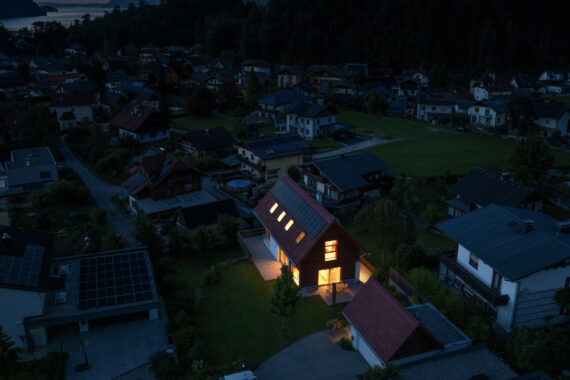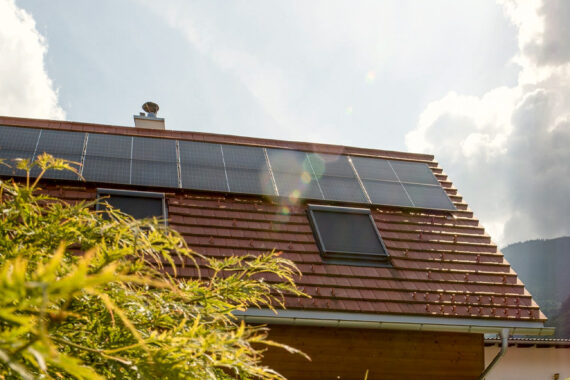Once you’ve decided to go for a PV system, you’ll be faced with a whole host of other questions that need to be answered. What is an inverter? Do you want a battery storage system, and are you thinking of buying an electric car in the future? And what do all these factors mean in terms of the size of the PV system? How much kWp do you need for your home?
My colleagues and I have already answered some of these questions on our blog. For example, you can click here to find out which inverter is the right one for you. Today we’ll be looking at how to decide on the size of your PV system. We’d like to start by discussing how abbreviations such as “kW” and “kWp” play into this and what they have to do with electricity consumption in your own home.

We then share some tips on how to roughly calculate your own electricity needs. Last but not least, we’d like to talk about the number of PV modules on the roof. How much power can each module generate, and how many do you need for your own PV system?
kW basics in brief
Robert Reinbrech, a solar expert at Fronius International, gives us a run-through of the abbreviations: “The abbreviation ‘kW’ is a common unit for measuring power. It stands for ‘kilowatt’ and is probably familiar to anyone who has mains electricity.”
- In other words, a “kilowatt” is a unit of power. To be precise, one kW contains 1,000 watts, as “kilo” is the Greek for “thousand”.
- But you’ll also see a “p” in the PV specs you get from your installer—what does that mean? This stands for “peak”, which brings us to “kWp” for “kilowatt peak”—this is simply the maximum yield of a PV system.
- Now let’s move on to “kWh”. A kilowatt-hour is the energy that a 1-kilowatt appliance needs to run for one hour. For example, if you use a hairdryer with a constant power of 1,000 watts (= 1 kW) for one hour, it will consume one kWh of electricity. Solar power production works in a similar way, except that electricity is generated in this case rather than consumed. A 10-kWp PV system can generate 10 kWh per hour at peak times under optimum operating conditions. To put this in perspective, that’s about the same amount as an average household of four people consumes every day. The question of how much electricity is flowing from the roof into the household grid at any given time depends, of course, on a range of factors such as solar radiation, shading, and many more.
- “It’s worth noting that utilities also use ‘kWh’, i.e., kilowatt hours to state the monthly and annual electricity consumption for billing purposes,” sums up Reinbrech.
How many kWh of electricity does my household need per year?
Many different factors determine the number of kilowatt hours of electricity a household consumes in a year. The most obvious one is that more people will need more electricity.
“Individual electricity needs by kWh can vary a lot depending on whether only working people live in a house or apartment and whether an electric car is being charged or an electric heat pump is used,” says Reinbrech, noting that living situations can make a big difference.

It’s also important to take hot water heaters and air conditioning systems into account when deciding on the size of your PV system.
If you want to put a number to your personal electricity consumption, the quickest way is to check your most recent annual bill. As long as you haven’t had a new baby or added housemates in the meantime, and you’re not moving out or planning on buying any large new appliances, your electricity needs shouldn’t fluctuate too much.
If you’ve recently moved house, don’t have figures from previous years to hand, or are looking to invest in an electric car or a heat pump, we have you covered. Just use the table below to get a rough idea of your (future) electricity needs.
Here’s how to calculate your electricity consumption
You can make a rough calculation based simply on the number of people living in your home. A single-person household consumes around 1,500 kWh per year, for example, while a 4-person household will use more than 3,500 kWh.
| Household size | Average electricity consumption per year |
|---|---|
| 1 person | approx. 1,500-2,000 kWh |
| 2 persons | approx. 2,000-2,800 kWh |
| 3 persons | approx. 2,800-3,500 kWh |
| 4 persons | approx. 3,500-4,500 kWh |
| 5 persons | approx. 4,500-5,500 kWh |
Now that you have these basic details, you can decide on the size of your PV system based on the general assumption that a PV system will generate around 1,000 kWh per year for each kWp. This means that a person living alone could cover their own annual electricity needs with a 1.5-kWp PV system, provided that conditions are perfect and all the solar energy generated is consumed without any losses. Under the same conditions, the average 4-person household could get by with a PV system with a power of 4.5 kWp.
Reinbrech advises: “It’s worth investing in a few extra kWp to give yourself the highest possible degree of self-sufficiency even during peak loads and the darker months of the year.”
Staying warm and cozy and ready to roll with PV: factoring in an electric car and heat pump
The figures mentioned above do not include heat pumps, air conditioning systems, or electric cars. However, these loads are some of the ones that require the most energy in the building, so it’s crucial to factor them into planning for a PV system as well. One thing we need to mention first is that the consumption of the items listed below is heavily dependent on how they are used. Here are the rough figures:
- Electric cars: The average electric car with an electricity consumption of 15 kWh per 100 kilometers consumes around 2,000 kWh with an annual mileage of 13,000 km.
Note: This means you need to add 2 kWp when calculating the size of your own PV system. - Heat pumps: This calculation is more complicated. Air-to-air heat pumps, for example, require significantly more electricity than systems that work with geothermal and groundwater heat. The size and energy rating of the property also play a key role. Our example is based on a single-family home with a living area of 120 m² and a heating requirement of 100 kWh/m². This gives us an annual heating requirement of 12,000 kWh. As we don’t heat the house all year round, we can estimate our annual electricity consumption to be between 2,400 and 4,300 kWh.
Based on this, you should add an average of 3.5 kWp to the PV system. - AC systems: In terms of cooling the home, we need to make a distinction between permanently installed split units and mobile air conditioning units. The latter are significantly less efficient and more energy-heavy. You can easily calculate the electricity requirements by multiplying the output of the air conditioning system times the number of operating hours per year. Based on a running time of 300 hours per year and a rather powerful 5-kW system, we get an electricity requirement of 1,500 kWh.
This means the PV system will need an additional 1.5 kWp on average.
Assuming that we have a household of four people including an electric car, a heat pump, and an air conditioning system, the household would need an 11.5 kWp PV system to cover its annual electricity needs with self-generated solar energy. As a little side note, the vast majority of families consume less electricity than the one in our example. Only in rare cases are both a heat pump and a separate air conditioning system used.
It’s all about the PV modules
You should be able to roughly estimate your annual electricity needs using the sample calculation above. What conclusions can you draw from this, and how many PV modules will you need for your individual number of kilowatt hours?
The answer depends first and foremost on the output of the PV modules you choose. Reinbrech explains: “Modern PV modules now have an output of between 400 and 500 Wp. This equates to around 300 to 500 kWh of solar power per PV module every year. Generally speaking, three 400-Wp PV modules will supply just over 1,000 kilowatt hours of electricity per year. This means that a 10-kWp system will have around 25 PV modules.”
The table below shows the approximate number of modules based on the desired output of the PV system:
| System power | PV modules required (rounded) |
|---|---|
| 1 kWp | 3 |
| 2 kWp | 5 |
| 3 kWp | 8 |
| 4 kWp | 10 |
| 5 kWp | 13 |
| 6 kWp | 15 |
| 7 kWp | 18 |
| 8 kWp | 20 |
| 9 kWp | 23 |
| 10 kWp | 25 |
| 11 kWp | 28 |
| 12 kWp | 30 |
| 13 kWp | 33 |
| 14 kWp | 35 |
| 15 kWp | 38 |

Remember: This information only applies under ideal conditions. In addition to the layout of the PV modules and their quality, the weather conditions at the location have a significant impact on the performance of the entire PV system. “Obviously, less solar energy is generated at higher latitudes and in winter. If parts of the roof are also shaded, for example due to neighboring buildings, trees, masts, or chimneys, the yields of the affected PV modules will be significantly reduced,” says the Fronius Solar expert, citing factors that can reduce the solar energy yield.
How big does the roof need to be?
A single PV module measures approx. 1.7 m², which means 5 m² of space is required per kWp. A relatively small roof with an area of 25 m² is sufficient for a 5-kWp PV system. However, if you want to generate 12 kWp or more of solar power on your own roof, the required PV modules will cover more than 60 m². Given that the average roof of a single-family home measures 100 m², this will take up a significant share of the available space.
The solar expert stresses: “If you’re a homeowner, don’t forget to subtract skylights and chimneys from the total area.” To get the most out of your system, you should also pay attention to shading as mentioned above.
In a nutshell
“kWp” stands for “kilowatt peak” and describes the maximum power of a PV system. You should plan on adding 1 kWp to your PV system for every 1,000 kWh of electricity consumed per year.
It’s best to use your electricity consumption from previous years as a guide when deciding on the size of the PV system. If you consumed 4,500 kWh of electricity, for example, a PV system starting at a power of 4.5 kWp will be a cost-effective solution for you. Before buying a system, make sure to ask yourself whether you want an electric car in the future or a heat pump to heat your living space. For loads of this type, you will want to increase the size of the PV system by 2-3 kWp in each case.
You need a roof area of 5 m² per kWp of power. A powerful 10-kWp PV system will thus cover at least 50 m² of your roof.
This blog post hasn’t looked at another factor that plays an important role in the size of the PV system: the energy storage system. You can find out how to (retro)fit this in your system and what storage capacity makes sense for your household in one of our next blog posts.






